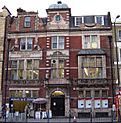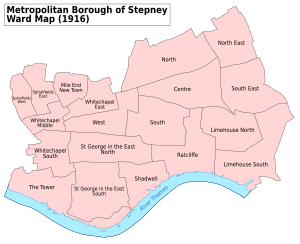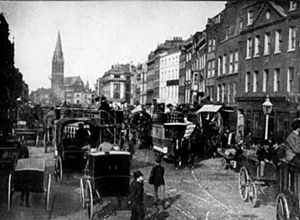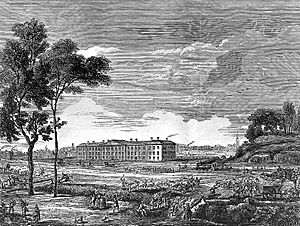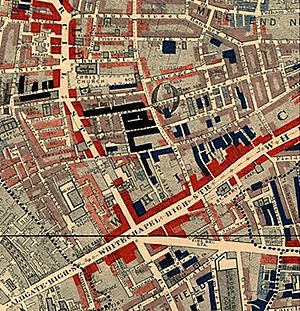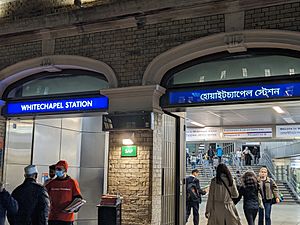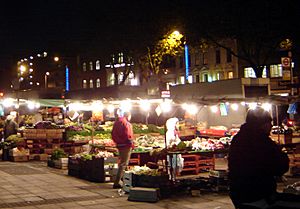Whitechapel facts for kids
Quick facts for kids Whitechapel |
|
|---|---|
|
Top from left: Royal London Hospital and Whitechapel Market; Aldgate East station, with the Whitechapel Gallery. Middle from left: East London Mosque; Vallance Gardens. Bottom from left: Altab Ali Park; Whitechapel Bell Foundry; |
|
| Population | 14,862 (Whitechapel ward 2011) |
| OS grid reference | TQ335815 |
| London borough | |
| Ceremonial county | Greater London |
| Region | |
| Country | England |
| Sovereign state | United Kingdom |
| Post town | LONDON |
| Postcode district | E1 |
| Dialling code | 020 |
| Police | Metropolitan |
| Fire | London |
| Ambulance | London |
| EU Parliament | London |
| UK Parliament |
|
| London Assembly | |
Whitechapel is a lively area in East London. It's about 5.5 kilometers (3.4 miles) east of Charing Cross, a central point in London. Whitechapel is known for its long history and diverse communities. It used to be part of Middlesex county but became part of London in 1889.
This area is close to the City of London and the London Docklands. Because of this, many immigrants and working-class people have made Whitechapel their home over the years. In the 1800s, it was a big center for London's Jewish community. Later, in the 1900s, it became a key place for the British Bangladeshi community. Whitechapel is also home to the famous Royal London Hospital and the East London Mosque. It was also the location of some historical events, including the Whitechapel murders in the late 1800s, which were linked to the unknown person known as Jack the Ripper.
Contents
History of Whitechapel
How Whitechapel Got Its Name

Whitechapel was originally part of a larger area called Stepney. As more people moved to the area, a small church was built around 1329. This church was called St Mary Matfelon. It was built so people didn't have to travel far to the main church in Stepney.
The name "Whitechapel" comes from this church. Like the White Tower at the Tower of London, the church was once painted white. This made it stand out and look nice. Around 1338, Whitechapel became its own independent parish, with St Mary Matfelon as its main church.
Whitechapel's Old Roads and Borders
Whitechapel's main street follows an old Roman road. This road connected London to Colchester in Essex, which was an important Roman town. Today, this historic road is called the A11 and runs through Whitechapel as Whitechapel High Street and Whitechapel Road. For many centuries, travelers stopped at inns along this road.
The old parish of Whitechapel stretched about 1,400 meters (about 0.87 miles) from the edge of the City of London. Its northern border included streets like Wentworth Street.
How Whitechapel Was Governed
Whitechapel became its own parish around 1338. At first, parishes mainly dealt with church matters. Later, they also helped with things like supporting the poor. Whitechapel was part of the historic county of Middlesex.
In 1889, Whitechapel became part of the new County of London. Then, in 1900, it joined the Metropolitan Borough of Stepney. More changes happened in 1965 when the Metropolitan Borough of Stepney merged with other areas to form the new London Borough of Tower Hamlets. At the same time, Whitechapel became part of Greater London.
Early Days of Whitechapel
Growing as a Suburb
Whitechapel was one of London's first suburbs outside the city walls. It was a good place for industries that needed a lot of space or created pollution, like tanneries and breweries. One famous business was the Whitechapel Bell Foundry. This foundry made famous bells, including Philadelphia's Liberty Bell and Big Ben in Westminster.
Many people moved from the countryside to London between the 1600s and mid-1800s. A lot of these people, who were often poor, settled in Whitechapel. They found work in the industries and services that supported the nearby City of London.
The Whitechapel Mount
The Whitechapel Mount was a large mound of earth on Whitechapel Road. No one is quite sure how it was formed. Many believe it was part of London's defenses during the Wars of the Three Kingdoms in the 1600s. It might have been part of a ring of forts that protected the city. The mound was removed in 1807–1808 to make way for new buildings.
Davenant Foundation School
In 1680, Ralph Davenant, who was a church leader in Whitechapel, and his family set up a school. They wanted to teach 40 boys reading, writing, and religious principles. Later, another person gave money so the children could also get clothes. The school, now called the Davenant Foundation School, moved to Loughton in Essex in 1966. The original site is now the Davenant Centre.
Royal London Hospital
The London Infirmary, now known as the Royal London Hospital, started in 1740. It was a hospital for sick people, especially workers, sailors, and their families. It moved to its current location on Whitechapel Road in 1757. In 1990, it was renamed the Royal London Hospital. A new, modern hospital building opened in 2012. The old hospital building became the new Tower Hamlets Town Hall in 2023.
Whitechapel in the 1800s
In the 1800s, Whitechapel became known for its poverty and crowded conditions. A map from 1889 by Charles Booth showed that while some main streets had people with good incomes (marked in red), many smaller streets were very poor (marked in black).
William Booth started his Christian Revival Society in Whitechapel in 1865. This group later became the Salvation Army in 1878. There's a statue in Whitechapel that remembers his work helping the poor.
Many immigrants, especially from Ireland and Jewish communities, moved to Whitechapel during this time. The Yiddish theatre actor Jacob Pavlovich Adler described the poverty in Whitechapel in the 1880s as worse than anything he had seen in Russia or New York.
The London County Council, formed in 1889, worked to build new homes and clear slums. This was a popular idea at the time.
Joseph Merrick, known as the "Elephant Man," became famous in Whitechapel. He was shown in a shop on Whitechapel Road before being helped by Frederick Treves at the Royal London Hospital. There's a museum at the hospital about his life.
Whitechapel in the 1900s
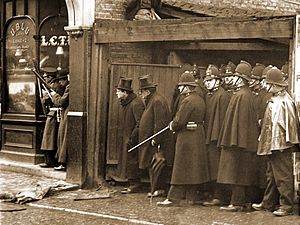
In 1902, American author Jack London lived in Whitechapel to write about the poor conditions. He wrote The People of the Abyss, saying that poverty in England was even tougher than in the United States.
Whitechapel was a place where many people wanted to make society better. Reformers and revolutionaries, like George Bernard Shaw and Vladimir Lenin, held meetings and rallies here. The Freedom Press, an anarchist publishing house, is still in Whitechapel today.
On October 4, 1936, a group called the British Union of Fascists planned to march through the East End, which had a large Jewish population. Hundreds of thousands of local people came out to stop the march. There were clashes with the police and the fascists, especially at Aldgate and Whitechapel, including at Gardiner's Corner. This event is known as the Battle of Cable Street.
The Halal restaurant, which opened in 1939, is the oldest Indian restaurant in East London. It was started to serve the many Indian sailors living in the area.
Whitechapel remained a poor area in the first half of the 1900s. It was heavily damaged by bombs during the Blitz in World War II. The old parish church, St Mary Matfelon, was badly damaged in 1940 and later torn down. Its former churchyard is now Altab Ali Park.
In 1978, a young Bangladeshi clothing worker named Altab Ali was murdered in Whitechapel. This racially motivated attack led to a huge response from the local Bengali community. The park where the old church stood was renamed Altab Ali Park in his memory.
Whitechapel in the 2000s
Whitechapel has continued to change in the 21st century. The Crossrail project, now called the Elizabeth line, has a station at Whitechapel. The station underwent a big renovation starting in 2010 to prepare for the new line and handle more passengers.
In 2012, the new Royal London Hospital building opened. The old hospital building was bought by the local council to become the new Tower Hamlets Town Hall.
In 2022, signs at Whitechapel station were updated to include "হোয়াইটচ্যাপেল" in Bengali. This was done to celebrate Bangladesh Independence Day and recognize the large Bangladeshi community in the area. Also in 2022, a historical marker was placed in Whitechapel to remember its importance as a center for Jewish refugees in the late 1800s and early 1900s.
Local Government
The local council offices will be located in the old Royal London Hospital building. The local library, called an Idea Store, is on Whitechapel Road.
Culture and Community

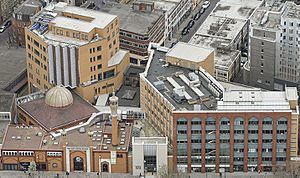
Whitechapel Road used to have two theaters in the 1800s: The Effingham and The Pavilion Theatre. The Pavilion Theatre later became a home for Yiddish theatre, serving the large Jewish population.
Since the 1970s, Whitechapel has been an important part of London's art scene. The most famous art place is the Whitechapel Art Gallery, which opened in 1901. It has become very well-known and supported.
Whitechapel has also been important for London's punk rock music scene. Places like Whitechapel Factory and Rhythm Factory have hosted many bands.
Who Lives in Whitechapel?
Bangladeshis are the largest ethnic group in Whitechapel, making up 40% of the population. The East London Mosque is one of the biggest mosques in Europe. It was built in 1985 and expanded in 2004 with the London Muslim Centre. Thousands of people worship there every week.
The Whitechapel Idea Store is a modern library built in 2005. It cost £12 million and was nominated for an award.
| Whitechapel compared 2011 | White British | Asian | Black |
|---|---|---|---|
| Whitechapel Population 14,862 | 24.4% | 49.8% | 4.4% |
| London Borough of Tower Hamlets | 31.2% | 41.2% | 7.3% |
Whitechapel in Books

Whitechapel appears in many books. Charles Dickens mentions it in Pickwick Papers and one of Fagin's hideouts in Oliver Twist was in Whitechapel.
Jewish authors like Israel Zangwill and Simon Blumenfeld wrote novels set in Whitechapel, showing the life of the Jewish community. Journey Through a Small Planet by Emanuel Litvinoff also describes Whitechapel and its Jewish residents in the 1920s and 1930s.
The novel Brick Lane by Monica Ali is set in Whitechapel. It tells the story of a young Bangladeshi woman living in Tower Hamlets in the 1990s and early 2000s.
Because of the Jack the Ripper history, Whitechapel is often used as a setting in stories about him. It's also the setting for the TV series Ripper Street.
Getting Around Whitechapel
Train and Tube Stations
Whitechapel has two underground stations: Aldgate East and Whitechapel.
- Aldgate East is on the District line and Hammersmith & City line.
- Whitechapel station is on these lines, plus the Elizabeth line and the East London Line.
The Docklands Light Railway (DLR) and the London, Tilbury and Southend line also pass through a small part of southern Whitechapel, but they don't have stations there.
Past Stations
Whitechapel station was once called Whitechapel (Mile End) because it was near the border with Mile End and Bethnal Green.
Aldgate East station used to be 150 meters (about 490 feet) west of where it is now. There was also another station called St Mary's (Whitechapel Road) near the East London Mosque. In the 1930s, when Aldgate East station moved closer, St Mary's station was closed because the stations were too close together.
Other Ways to Travel
Many London Buses routes serve Whitechapel, including routes 15, 25, 106, 115, 135, 205, 254, D3, N15, N205, N253, N550, and N551.
Whitechapel is connected to the main road network by the A11 (Whitechapel Road) and, to the south, the A13 and The Highway (A1203). There's also a Cycle Superhighway CS2 that runs from Aldgate to Stratford along the A11.
Nearby Places
- Bethnal Green
- City of London
- East Smithfield
- Spitalfields
- Tower Hill
- Wapping
- Mile End
- Mile End New Town
 |
Spitalfields | Bethnal Green and Spitalfields | Bethnal Green |  |
| City of London | Stepney | |||
| Wapping | Shadwell and Wapping | Stepney and Shadwell |
Famous People from Whitechapel
Many interesting people were born or lived in Whitechapel:
- Damon Albarn – a musician, lead singer of Blur and co-creator of Gorillaz, born in 1968.
- Abraham Beame – the first Jewish mayor of New York City.
- Jack Kid Berg – a boxer known as "The Whitechapel Windmill."
- Jack Cohen – who founded the Tesco supermarket chain.
- Ashley Cole – a famous footballer for Chelsea and England.
- Bud Flanagan – a well-known comedian from music halls.
- Micky Flanagan – a popular comedian.
- Kenney Jones – the drummer for famous bands.
- Emanuel Litvinoff – an author who wrote about Jewish life in Whitechapel.
- Abe Saperstein – the person who started the Harlem Globetrotters basketball team.
- Sarah Taylor – a cricketer.
Other notable people connected to Whitechapel include:
- Altab Ali – a young man whose murder in 1978 led to community action.
- Mary Hughes – a social worker who helped people in need.
- Jack the Ripper – an unidentified historical figure linked to events in the area.
- Jack London – the author who wrote The People of the Abyss after staying in Whitechapel.
Images for kids
See also
 In Spanish: Whitechapel para niños
In Spanish: Whitechapel para niños
- British Bangladeshi
- Stepney Historical Trust
- Whitechapel Mount



